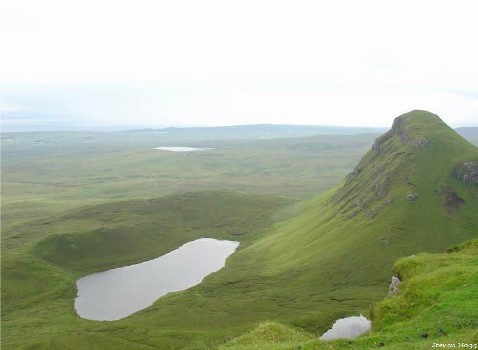

Above, images of Scotland for your viewing pleasure
In the previous section, I reported that I had found evidence of about 1,500 Wightons who lived in Scotland between 1553 and 1854. However, I have to confess that this figure is not very accurate. In fact, 1,500 Wightons is a low estimate of the number of Wightons who lived in that time period. Here's why.
Birth and marriage data on early Scottish inhabitants are found in the parish records that were kept at the time. Parishes were instructed to begin collecting those data in 1553, but they were given leeway as to when they started. This lead to a lot of inconsistency. For example, only a few of the parishes where our early ancestors lived had records before 1600 (e.g., Monifieth in 1560, Perth in 1561). Most of Scotland's parishes began collecting data in the 1600s but that could mean 1605 or even 1699. The remaining parishes didn't start to collect information until well into the 1700s. This staggered start to the record keeping means that Wighton births were heavily under-reported. For example, I found evidence of 8 Wighton families living in Alyth in 1623 when records began. This suggests one or two Wighton families in Alyth in the previous generation. Who knows how far back that family went? I found many instances of multiple Wightons appearing in a parish's records within a few years of the initiation of those records, thus suggesting that they had an established presence in the parish. For this reason alone, there had to have been many more than 1,500 Wightons living in Scotland between 1553 and 1854.
Here's another reason why that 1,500 figure is low. Look at this analysis of the number of Wightons born before 1725.
| Male | 57% |
| Female | 40% |
| Not reported | 3% |
As you can see, there are considerably more males than females. There's a simple explanation that any Wighton male could easily endorse. However, our modesty would preclude any lengthy discussion of the potent virility coursing through our bodies. For those of you who would not subscribe to the theory that Wighton men just naturally produce many more males than females (it's not because we want to, we just can't help it....), some other explanation must be sought. This disparity between male and female births is too large, and is found over too long a time period for it to be random happenstance.
The answer to our puzzle can be found in the words of a parish minister describing his parishioners in The Statistical Accounts of Scotland published in 1795. (Every parish minister in Scotland contributed to this account by answering a set of questions on their parish's geography, the inhabitants, agriculture, industry, etc.) The minister noted with satisfaction that all parishioners were being duly married in the church, but he decried the fact that all births were not being similarly recorded. We know that in Scotland at the time, the pressure to marry formally in the church was very high, but this statement suggests that the church had less success in requiring its parishioners to record the births of their children. The fact that the church charged fees (occasionally quite exorbitant) for birth, marriage and death formalities was undoubtedly a factor, especially for the average agrarian family already living close to starvation. As a result, the births of both genders were under-reported, but the status of females at the time would have lead to fewer girls than boys being baptized.
Here's a third, albeit relatively minor, impact on the accuracy of my finding. The 20th century staff who had to interpret the parish records in order to enter the information into a database had to cope not only with a wide range of handwriting styles/legibility, but they were also dealing with records written in ink centuries ago. It would be quite easy to misinterpret a parish scribe's handwriting or to guess incorrectly at some faint name. I found a number of these cases (see below for 7 of them). Did I find them all? Probably not.
| 1620: Johne Wichttovne was married in the Parish of Monikie |
| 1656: William Vightin was born to Johne Vightin in the parish of Alyth |
| 1674: Thomas Uitghton was married in the Parish of Cargill |
| 1709: Isobell Nighton was married in the Parish of Blairgowrie |
| 1728: John Weghtown was born in the Parish of Cargill |
| 1740: Thomas Highton was married in the Parish of Gordon |
| 1791: Anne Weignton born to Henry Weignton in the Parish of Arbroath |
Finally, the number of transcription errors in the database pales in comparison to the number of birth and marriage records that were not stored under the Wighton surname. This is because Scottish surnames were not spelt in a consistent manner prior to the 19th century. A parish scribe would receive the information on the child's birth orally and would then record the data phonetically. That scribe might record the family's name consistently for subsequent births to that father or he might not. For example, I found plenty of cases of two or even three different spellings of the Wighton name for children born to the same father and in the same parish. Moreover, outside that parish, other parish scribes were writing the same family name in their own legitimate phonetic version.
To get an accurate picture of the family lineage. I searched for every possible phonetic spelling of our surname. Did I get them all? Possibly not. For example, there are a large number of Witton families in Scotland with whom we are not related. It is entirely possible that some of our family members had their last names transcribed in that spelling by mistake. The surnames are relatively close in phonetic pronunciation; however, I did not go through the thousands of Witton names trying to see if any of them were ours.
Sources
Family Search: The Latter Day Saints Database (http://www.familysearch.org)
ScotlandsPeople Database (http://www.scotlandspeople.gov.uk/)
Statistical Accounts of Scotland (http://edina.ac.uk/stat-acc-scot/)